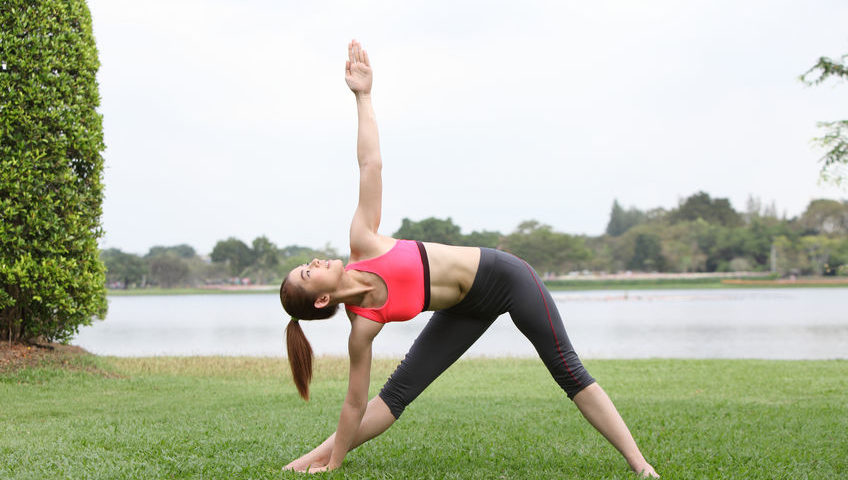Trikona – Triangle, Asana – Pose; Sanskrit: त्रिकोणासन; Pronounced as – trih-koh-nah-sah-nah
This asana resembles a triangle, and therefore, is named so. The name comes from the Sanskrit words त्रिकोण (trikona), meaning triangle, and आसन (asana), meaning posture. This asana is known to stretch the muscles and improve the regular bodily functions. Unlike most other yoga asanas, this requires you to keep your eyes open while you practice it to maintain balance.
Like the other yoga asanas, it is essential that your stomach and bowels are empty when you practice the asana. Make sure there is a gap of at least four to six hours between your meal and practice. This will give you enough time to digest your food and generate energy for your practice.
Also, mornings are ideal to practice yoga. But, in the event you cannot practice yoga in the morning, evenings are a good time too.
Level: Beginner
Style: Vinyasa
Duration: 30 Seconds
Repetitions: 3 to 5 on each leg
Strengthens: Ankles, Thighs, Knees
Stretches: Ankles, Groin, Thighs, Shoulders, Knees, Hips, Calves, Hamstrings, Thorax, Vertebral column
How To Do Trikonasana
1. Stand upright and place your legs about three and a half to four feet apart.
2. Make sure your right foot is placed outside at 90 degrees and the left foot is placed in at 15 degrees.
3. Align the center of your right heel with the center of the arch of the left foot.
4. You need to remember that your feet are pressing the ground, and the weight of your body is balanced equally on both feet.
5. Take a deep breath, and as you exhale, bend your body to the right from below your hips, ensuring your waist is straight. Lift your left hand up and let your right hand touch the ground. Both your arms should form a straight line.
6. Depending on the level of comfort, rest your right hand on your shin, ankle, or outside the right foot on the floor. No matter where you place your hand, make sure you do not distort the sides of your waist. Quickly check on your left arm. It should be stretched out towards the ceiling and in line with the top of your shoulder. Let your head sit in a neutral position or turn it to the left, with your gaze set on your left palm.
7. Your body should be bent sideways, and not backward or forward. Your chest and pelvis should be wide open.
8. Stretch to the fullest, and focus on stabilizing your body. Take deep, long breaths. With every exhalation, try and relax your body more.
9. Inhale and come up. Drop your arms to your side and straighten your feet.
10. Repeat the same using the left leg.
Benefits Of Trikonasana
Take a look at the amazing Trikonasana benefits.
1. It strengthens the knees, ankles, legs, chest, and arms.
2. It completely stretches and opens up the groins, hips, hamstrings, and calves and also the chest, spine, and shoulders.
3. It increases both physical and mental stability.
4. It improves digestion and stimulates all the abdominal organs.
5. It helps reduce back pain and sciatica. It also serves as a therapy for flat feet, osteoporosis, neck pain, and infertility.
6. It reduces stress and cures anxiety.
The Science Behind The Trikonasana
This asana lets you realize how much you take your legs for granted. Your legs are graceful and powerful. When you feel disconnected with the lower half of your body, Trikonasana can revive your faith in the wonders of your lower body.
This asana instills expansion, stability, and evenness. These are the three physical principles of hatha yoga.
This asana, like many others, is a combination of many elements. It instills strength and stability in the legs and the feet and expands the torso. When your arms and legs are stretched out, it creates evenness (sama) in the body. As you balance your legs, arms, and torso, your mind becomes even and steady. As your mind extends itself to the shores of your body, and you turn your awareness inward, the true experience of yoga, or union, begins.


















Discussion about this post